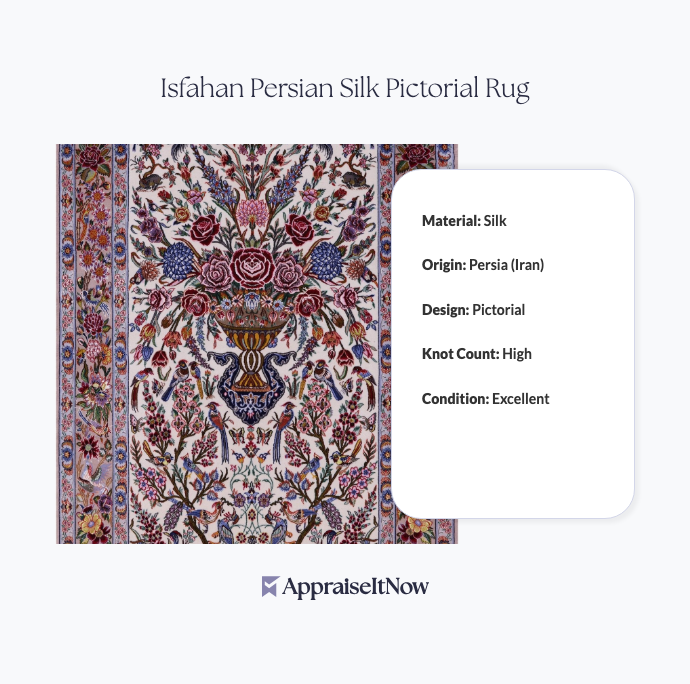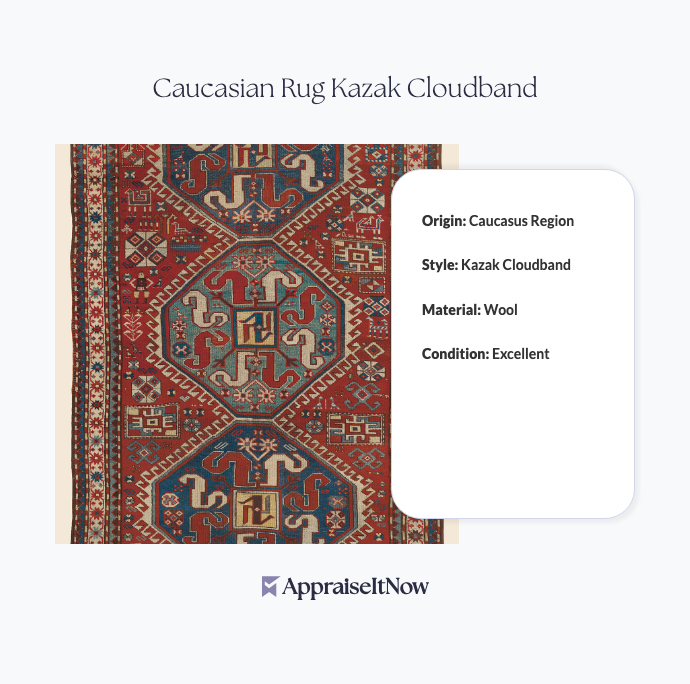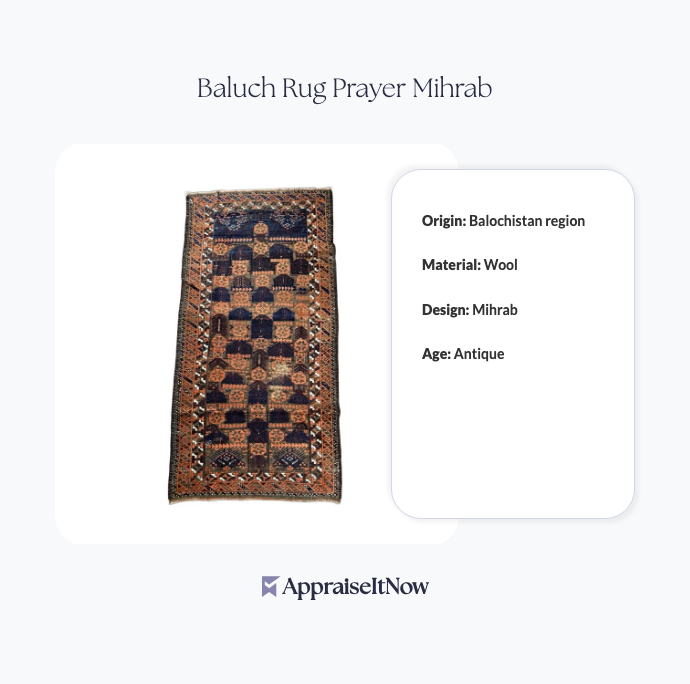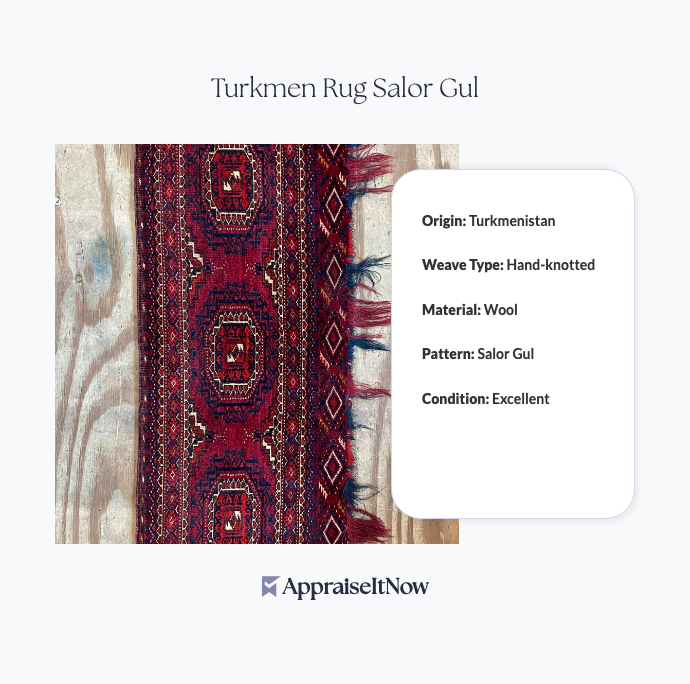<h1>How to Get Your Isfahan Persian Silk Pictorial Rug Appraised</h1>
<p>An Isfahan Persian silk pictorial rug is far more than floor covering—it's a masterpiece of centuries-old textile artistry, often worth <strong>$40,000 to $50,000</strong> or more. Whether you're planning to sell, need insurance documentation, or simply want to understand what you own, obtaining a professional appraisal is essential. A certified valuation protects your investment and ensures you understand the true market value of this extraordinary piece.</p>
<h2>Understanding What Makes Your Isfahan Rug Valuable</h2>
<p>Isfahan rugs represent the pinnacle of Persian rug craftsmanship, first introduced in the <strong>16th century</strong> and refined to extraordinary levels of sophistication. Your particular rug features hand-knotted silk threads and an intricate pictorial design—hallmarks that distinguish it from other Persian rugs and drive its significant value.</p>
<p>The value of a Persian Isfahan silk pictorial rug depends on several converging factors. <strong>Age</strong> is fundamental—rugs from earlier periods command premium prices. <strong>Knot density</strong> reveals the artisan's skill; Isfahan rugs typically feature <strong>over 300 knots per square inch</strong>, with museum-quality pieces exceeding 500 knots per inch. The type of <strong>materials</strong> matters tremendously; genuine silk creates a luminous quality that cotton or wool cannot replicate. The <strong>pictorial complexity</strong> of your design—whether it depicts historical scenes, garden landscapes, or hunting narratives—directly affects both aesthetic and monetary value.</p>
<div class="callout tip"><p><strong>Valuation Insight</strong></p>
<p>Isfahan rugs are estimated to represent fewer than 500 examples worldwide, making each authenticated piece exceptionally rare and desirable.</p></div>
<h2>Distinguishing Authentic Isfahan Rugs from Reproductions</h2>
<p>Before investing time in appraisal, you need confidence that your rug is genuinely what it claims to be. How do you tell the difference between authentic Isfahan silk pictorial rugs and reproductions or machine-made copies?</p>
<p>Authentic Isfahan rugs display several technical signatures. The <strong>hand-knotted construction</strong> creates irregular knot spacing (intentional variations reflecting human artistry), while machine-made rugs show mechanical precision. <strong>Silk quality</strong> in authentic pieces has a distinct luminosity and weight; inferior silk or silk blends lack this characteristic glow. The <strong>back of the rug</strong> reveals truth—authentic hand-knotted pieces show clearly visible knots with individual color variations, whereas reproductions display uniform patterns or machine-finished backings.</p>
<p><strong>Visual inspection</strong> of your pictorial design offers clues as well. Authentic Isfahan weavers incorporated subtle asymmetries and color variations that appear almost imperceptible but distinguish hand-created work from mechanical reproduction. The colors themselves provide evidence; natural vegetable dyes used in older rugs display fading patterns and depth that synthetic dyes cannot achieve.</p>
<p>A qualified appraiser will examine thread fiber under magnification, analyze dye composition, and assess construction techniques to authenticate your piece before valuation proceeds.</p>
<h2>Condition and Its Impact on Appraisal Value</h2>
<p>Professional appraisers quantitatively assess how condition affects value—an often-overlooked but critical component of Isfahan rug appraisals. Your rug's market price depends substantially on its physical state.</p>
<p><strong>Wear patterns</strong> tell the rug's story and impact value accordingly. Light wear consistent with age—what collectors call "appropriate patina"—often enhances value by demonstrating authentic use. Conversely, heavy foot traffic wear, fraying edges, or worn binding significantly reduce value. <strong>Stains and discoloration</strong> require careful evaluation; minor staining may reduce value by 10-20%, while extensive staining can reduce it by 40% or more depending on removal feasibility.</p>
<p><strong>Moth damage</strong> presents particular concern for silk rugs. Even small moth holes can reduce value substantially, as they indicate vulnerability to ongoing pest damage. <strong>Restoration or professional conservation treatments</strong> create nuanced impact—expert conservation that preserves originality may sustain or slightly enhance value, but overrestoration (replacing original threads or dyeing to mask aging) often reduces market price by 30-50%.</p>
<p>The distinction matters enormously: an Isfahan rug in excellent condition with minimal wear commands premium pricing, while a similar rug with significant restoration history sells at 40-60% discount despite functional similarity.</p>
<div class="callout note"><p><strong>Conservation Consideration</strong></p>
<p>Professional conservation differs from aggressive restoration. Proper conservation stabilizes threads and colors while respecting originality—this preserves value, whereas excessive restoration can diminish it.</p></div>
<h2>Documentation and Provenance That Increase Value</h2>
<p>What documentation most increases buyer confidence and value? Professional appraisers recognize that provenance is often as important as the rug itself.</p>
<p><strong>Previous sales receipts</strong> and <strong>original purchase documentation</strong> establish price history and verify authenticity at point of sale. <strong>Exhibition history</strong> demonstrates that museum curators or recognized institutions have deemed your rug worthy of display—a powerful validation signal. <strong>Previous professional appraisals</strong> from recognized experts provide baseline valuations and condition documentation from earlier periods, allowing appraisers to track condition changes.</p>
<p><strong>Photographs taken at acquisition</strong> prove invaluable, particularly for insurance purposes. When combined with current images, they document condition changes and provide visual records for underwriters. <strong>Certificates of origin</strong> from reputable dealers carry significant weight, especially if they specify the region (Isfahan city versus Isfahan-style rugs from other Persian regions), approximate age, and materials used.</p>
<p>Collectors who maintain <strong>exhibition catalogs</strong>, <strong>dealer correspondence</strong>, or <strong>family provenance records</strong> documenting how they acquired the rug add substantial value justification. We recommend exploring our detailed guide on <a href="/blog/appraising-fine-textiles-valuing-antique-fabrics-and-weavings">appraising fine textiles</a> for comprehensive provenance documentation strategies.</p>
<h2>Identifying Signature Weavings and Premium Makers</h2>
<p>Are there signature weavers from Isfahan whose rugs command premium prices? Yes—certain families and workshops earned legendary status for their distinctive styles and extraordinary craftsmanship.</p>
<p>The <strong>Mohtasham workshop</strong> stands among the most revered Isfahan rug makers, known for exceptionally fine knot density and naturalistic pictorial designs. <strong>Master weavers signed or marked their work</strong> through distinctive design elements, color palettes, or structural variations recognizable to trained appraisers. These maker-identified rugs often command 30-50% premiums over unsigned examples of comparable quality.</p>
<p>Regional variations within Isfahan also matter. Rugs from the <strong>central Isfahan city workshops</strong> typically command higher prices than "Isfahan-style" rugs produced in surrounding regions. Your appraiser will examine design elements, construction techniques, and material choices to identify maker signatures and regional characteristics that establish pricing within the <strong>$40,000-$50,000 range</strong> or beyond.</p>
<h2>Professional Appraisal Standards and Appraiser Credentials</h2>
<p>Do appraisal reports for Persian rugs need to be USPAP-compliant for insurance, estate, or tax purposes? Absolutely. When high-value assets require documentation for legal proceedings, insurance replacement, or estate settlement, your appraisal must meet <strong>Uniform Standards of Professional Appraisal Practice (USPAP)</strong> requirements.</p>
<p>Qualified appraisers hold recognized credentials including <strong>American Society of Appraisers (ASA)</strong>, <strong>International Society of Appraisers (ISA)</strong>, <strong>American Academy of Appraisers (AAA)</strong>, or <strong>Certified American Gem Appraisers (CAGA)</strong>. For textile and fine art specialization, look for designations in <strong>decorative arts</strong> or <strong>fine carpets and rugs</strong>.</p>
<p>AppraiseItNow connects you with credentialed appraisers across the nation who provide <a href="/types/artwork">USPAP-compliant valuations suitable for insurance, estate planning, and legal documentation</a>. Your appraiser will deliver a detailed report including condition assessment, historical context, comparable market analysis, and certified valuation—documentation that stands up to professional scrutiny.</p>
<div class="callout tip"><p><strong>Credential Verification</strong></p>
<p>Before engaging an appraiser, verify their credentials with the issuing organizations and confirm their specific experience with Persian carpets and rugs.</p></div>
<h2>Market Pricing and Sales Channels</h2>
<p>How do prices for Isfahan silk pictorial rugs typically range in recent auction and dealer markets? Recent sales data shows considerable variation based on size, age, and condition. A quality Isfahan pictorial rug measuring <strong>6 × 9 feet</strong> in excellent condition commands $40,000-$60,000, while smaller pieces (4 × 6 feet) may range $25,000-$40,000. Exceptional museum-quality examples or historically significant pieces exceed these ranges substantially.</p>
<p><strong>Auction house sales</strong> at major firms like Sotheby's or Christie's provide transparent price discovery but involve commission costs (typically 10-25%). <strong>Specialist dealers</strong> often achieve negotiated prices outside public view, sometimes exceeding auction results through private treaty sales. <strong>Online marketplaces</strong> for high-value collectibles have emerged as viable alternatives, though <a href="/blog/appraising-fine-carpets-and-rugs-valuing-artistry-beneath-your-feet">authentication and condition assessment</a> remain critical.</p>
<p>Your appraiser can reference recent comparable sales to position your specific piece within the market, accounting for regional variations, seller circumstances, and current collector demand.</p>
<h2>International Considerations and Legal Aspects</h2>
<p>Are there export, import, cultural heritage, or legal considerations affecting sale or transportation of antique Persian rugs internationally? Yes—several factors require careful attention if you're selling across borders or shipping internationally.</p>
<p><strong>Cultural heritage restrictions</strong> limit export of certain textiles from Iran, particularly those of exceptional age or artistic significance. While your Isfahan rug likely faces no restrictions if legally acquired, understanding export regulations in your country and import regulations in the buyer's country prevents complications.</p>
<p><strong>Documentation becomes particularly important</strong> for international transactions. Appraisals from recognized international appraisers facilitate customs clearance and establish legitimate value for import duties. <strong>Insurance during transport</strong> requires detailed appraisal documentation; international carriers demand certified valuations before providing coverage.</p>
<p>Professional appraisers familiar with international transactions can reference comparable sales from global markets and provide documentation that satisfies customs authorities and international buyers.</p>
<h2>Professional Appraisal Value and Documentation Benefits</h2>
<p>A professional appraisal of your Isfahan Persian silk pictorial rug serves multiple essential purposes. For <strong>insurance coverage</strong>, your policy should reflect current market value; a certified appraisal prevents underinsurance and ensures replacement cost coverage if loss occurs. For <strong>estate planning</strong>, documented valuations clarify asset distribution and facilitate tax calculations. For <strong>sale transactions</strong>, whether through auction houses, dealers, or private buyers, a professional appraisal establishes defensible pricing and builds buyer confidence.</p>
<p>The appraisal process itself becomes educational—your appraiser explains your rug's historical significance, artistic merit, and market positioning. You'll understand not just the monetary value, but the cultural heritage your piece represents within Persian textile tradition dating to the 16th century.</p>
<div class="callout note"><p><strong>Key Takeaway</strong></p>
<p>A certified USPAP-compliant appraisal gives you confidence, accuracy, and professional documentation that protects your investment whether you're buying, selling, insuring, or planning your estate. Understanding your Isfahan Persian silk pictorial rug's estimated value of $40,000-$50,000 requires expertise in Persian weaving traditions, market analysis, and condition assessment—exactly what credentialed appraisers provide.</p></div>
<p>For comprehensive guidance on valuing your textile treasures, explore our resources on <a href="/blog/appraising-tribal-rugs-and-textiles-exploring-artistic-traditions-and-techniques">appraising tribal rugs and textiles</a> and <a href="/blog/understanding-artwork-appraisals">understanding artwork appraisals</a> to ensure your valuable piece receives the expert evaluation it deserves.</p>







.avif)







